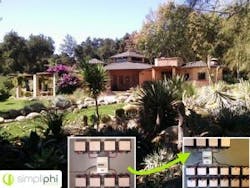Students at Santa Fe Community College will soon study energy on their own campus microgrid. As reported by the Microgrid Systems Laboratory, the college is collaborating with the National Renewable Energy Laboratory (NREL) and the Microgrid Systems Laboratory (MSL) to develop a campus microgrid comparable to university microgrid installations.
It will link existing assets, including a 1.5 MW photovoltaic array and a district heating and cooling system, with new technology capable of demonstrating the full range of microgrid functionality. Phase one, a new greenhouse facility, will illustrate advanced aquaponics and hydroponics techniques, highly efficient uses of water, energy, and recycled wastes, and a nanogrid that optimizes energy generation, storage and consumption.
In parallel with the campus infrastructure development, SFCC launched a curriculum for spring 2016. Thanks to the campus microgrid, students will be able to experience hands-on exercises in a functional environment. The campus microgrid is expected to eventually integrate with NREL’s Energy Systems Integration Facility for grid-scale simulations and modeling, along with other regional microgrid assets. NREL will also evaluate the larger campus infrastructure goals as the context for this initial phase, with an eye toward subsequent stages of development.
***
Clean, renewable energy for Canadian energy customers through virtual power plant
Residential energy customers in Ontario, Canada are working together to create a virtual power plant that will generate clean, renewable energy and reduce their dependence on the provincial grid. Community-owned energy company PowerStream unveiled POWER.HOUSE, the virtual power plant that uses an aggregate fleet of 20 residential rooftop solar PV panels and lithium-ion battery storage, located at customer homes, that can be autonomously controlled through intelligent software to simulate a single, larger power generating facility.
It’s a win-win for customers and utilities alike. The fast-responding energy storage assets can be used to reduce peak system loads, regulate frequency, and even defer capital costs associated with traditional electricity delivery infrastructure. In addition to generating clean, renewable energy, customers will be less exposed to the provincial grid’s peak electricity rates and will likely see a significant reduction in their energy bills. With on-site stored and solar energy, they’ll also be more protected from grid outages.
PowerStream received grant funding from IESO for the project, and partnered with Sunverge Energy and Robertson Bright to build the initial offering.
***
Additional battery storage, off-grid power for California eco resort
Taft Gardens was challenged to preserve the pristine natural environment of the gardens (read: no trenching power lines) while at the same time generating and harvesting enough off-grid power to accommodate expanding operations at the remote location. In phase two of its off-grid solar plus installation, California Solar Electric installed a scalable, non-toxic battery solution from SimpliPhi Power that is proven to perform in hot climates like Southern California. Eight additional 2.6 kWh batteries were added to the existing installation, doubling the PHI power storage and providing enough power capacity to run electrical loads well into the night — without utilizing a generator.
“For Taft Gardens, this approach allowed us to fully utilize a distributed energy model of power generation and storage assets to make each building independent and power secure beyond the traditional limits of the transmission grid,” said California Solar Electric CEO Don Campbell.
For more on campus microgrids, virtual power plants and battery storage, follow @MicrogridNews.







